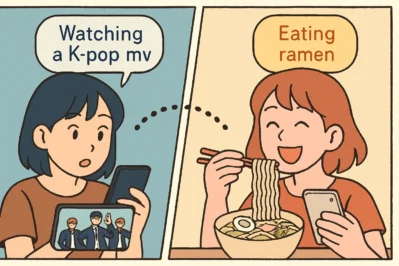What’s Your Bias Doing Now? Master the Korean Present Tense (~고 있어요)!
Hello! This is Maeil Hangul, here to upgrade your Korean skills!
Have you ever been texting a friend and wondered how to say, “What are you doing?” or “I’m eating right now”? Today, we’re going to learn one of the most useful grammar points for daily conversation: the present continuous tense, ~고 있어요 (-go isseoyo).
Especially in Korea, where people love to share what they’re doing in real-time, this expression is essential. You’ll hear K-Pop idols use it all the time during their live streams to connect with fans. By the end of this lesson, you’ll be able to do the same!
Core Expressions You Need to Know
Here are the key building blocks for talking about what’s happening right now.
1. The Magic Formula: V + ~고 있어요
* Korean Expression: ~고 있어요
* Pronunciation [Romanized]: -go i-sseo-yo
* English Meaning: I am ~ing / (Subject) is ~ing
* Detailed Explanation: This is the grammar pattern you attach to a verb to show an action is currently in progress. It’s the Korean equivalent of “verb + -ing” in English. Simply take a verb, drop the 다 (da) at the end, and add ~고 있어요. For example, 가다 (gada - to go) becomes 가고 있어요 (gago isseoyo - I am going). It’s a polite form (요), so you can use it with almost anyone!
2. The Main Phrase: 샤워하고 있어요
* Korean Expression: 샤워하고 있어요
* Pronunciation [Romanized]: Sya-wo-ha-go i-sseo-yo
* English Meaning: I’m taking a shower.
* Detailed Explanation: This is a perfect example of our grammar in action. The verb “to take a shower” is 샤워하다 (syawóhada). We drop the 다 (da) and add 고 있어요 to say you’re in the middle of showering. It’s a very common and natural phrase.
3. The Essential Question: 뭐 하고 있어요?
* Korean Expression: 뭐 하고 있어요?
* Pronunciation [Romanized]: Mwo ha-go i-sseo-yo?
* English Meaning: What are you doing?
* Detailed Explanation: This will be one of your most-used questions! 뭐 (mwo) means “what,” and 하다 (hada) means “to do.” So, you are literally asking, “What are you in the process of doing?” Memorize this phrase!
Example Dialogue
Let’s see how these expressions are used in a real conversation. Imagine two friends, A and B, texting each other.
- A: 소미야, 지금 뭐 하고 있어?
- Somi-ya, jigeum mwo hago isseo?
- (Hey Somi, what are you doing right now?)
- (Note:
있어is the casual form of있어요, used with close friends)
- B: 나? 지금 BTS 새 뮤직비디오 보고 있어! 진짜 짱이다!
- Na? Jigeum BTS sae myujikbidio bogo isseo! Jinjja jjang-ida!
- (Me? I’m watching the new BTS music video right now! It’s so awesome!)
- A: 와! 나도 볼래! 너 저녁은? 밥 먹고 있어?
- Wa! Nado bollae! Neo jeonyeogeun? Bap meokgo isseo?
- (Wow! I want to watch it too! What about dinner? Are you eating?)
- B: 아니, 뮤직비디오 다 보고 먹을 거야.
- Ani, myujikbidio da bogo meogeul geoya.
- (No, I’m going to eat after I finish watching the music video.)
Culture Tip & Trend Deep Dive
Live Communication Culture in Korea!
In Korea, sharing your current status is a big part of daily communication, especially on social media. K-Pop idols on platforms like Weverse or Instagram Live are masters of this. They constantly interact with fans by saying:
- “저 지금 연습하고 있어요.” (jeo jigeum yeonseuphago isseoyo.) – “I’m practicing right now.”
- “팬들이 남긴 댓글 읽고 있어요.” (paendeuri namgin daetgeul ilgo isseoyo.) – “I’m reading the comments left by fans.”
When you use ~고 있어요 with your Korean friends, it makes you sound very natural and engaged in the moment. It shows that you’re sharing your “now” with them, which is a key part of building friendships in Korea.
Let’s Wrap It Up & Practice!
Amazing work today! You learned how to describe actions happening right now using ~고 있어요. It’s simple: just add it to a verb stem!
Now, let’s test your skills.
1. Fill in the Blank:
Your friend asks you, “뭐 하고 있어요?” You are currently listening to music. How do you respond?
(Hint: The verb ‘to listen’ is 듣다 [deutda])
- 저는 음악을 __________. (jeoneun eumageul ________.)
2. Make a Sentence:
How would you say “I am studying Korean” using the polite ~요 form?
(Hint: ‘To study Korean’ is 한국어를 공부하다 [hangugeoreul gongbuhada])
You’ve got this! Try answering the practice questions in the comments below.
What are you doing right now? Leave a comment using the ~고 있어요 grammar we learned today!






